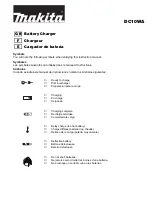
4
ASSEMBLY INSTRUCTIONS
Attach the handle to the charger using the four screws provided. Attach the front leg to the base with
the four hex head screws provided. To attach wheels and axle to the base, tap one axle nut onto the
axle with a hammer, slide one wheel onto the axle. Push the axle through the base, place wheel on
opposite side. Tap axle nut onto the axle with a hammer.
OPERATING INSTRUCTIONS
CAUTION
- This battery charger must be fully assembled before operating. Failure to do so may
result in risk of injury.
USE OF INSTRUMENT PANEL:
The MINUTES CHARGE timer has an OFF position, a CONTINUOUS
CHARGE position and a timed charge range from 0 to 120 minutes.
a.
OFF
- Always make sure the timer is in the OFF position before
connecting or disconnecting the clamps from the battery. The charger will
not charge with the timer in this position.
b.
CONTINUOUS CHARGE
- This position is used for slow charging or
parallel charging and will not turn the charger off. Do not use this position
for fast charging.
c.
0 to 120 MINUTES TIMED CHARGE
- The timer will automatically turn the charger off at the end of the pre-set
charging time. Turn the timer past 20 before setting the desired time.
d.
VOLTS/AMPS CHARGE SWITCHES
- These switches are used to regulate the output voltage and current of the
battery charger.
TO CHARGE BATTERIES
Make connections to the battery per the instructions in preceding section of this manual. Determine the battery
voltage and set initial charge rate settings per chart. Turn the timer on. If a higher rate of charge is desired, turn
the AMPS CHARGE switch to the appropriate 2, 3, 4 or HI position. Always return the AMPS CHARGE switch to
the LO position before advancing the VOLTS CHARGE switch.
12V CRANKING ASSIST AND BOOST STARTING
Turn off all lights and accessories in the vehicle.
Connect the charger to battery per previous instructions. Charge the battery at least five minutes. Make sure the battery is accepting current
before setting charger to crank assist. Always start on the lowest amperage crank setting. Put the switch in the "12V CRANK ASSIST"
position. Start the car with the charger connected to the battery. Follow the duty cycle on the unit. Turn the switch to OFF and remove the
AC power cord from the electric outlet before disconnecting the DC clamps.
DIESEL VEHICLES
Diesel engines have special starting requirements due to the high compression required to ignite the fuel mixture. Because of this, the starter
motors have to work harder which requires the battery to deliver a large amount of power for a period of time. Adequate voltage must be
supplied also to insure the glow plug will have enough power to preheat the chamber. When attempting to start a diesel vehicle, always fast
charge the battery at least five minutes. If time permits, charge the battery as long as possible or until the battery reaches 75% state of
charge. Make sure the battery is accepting current before setting charger to crank assist. Always start on the lowest amperage crank setting.
With the charger "ON" and attached to the battery, attempt to start the vehicle. Do not crank the engine more than 20 seconds in a five-minute
period. While allowing the starter to cool, allow the charger to continue to charge the battery.
If the vehicle has two batteries installed, read the "VEHICLES WITH TWO BATTERIES" section of this manual.
VEHICLES WITH TWO BATTERIES
Many diesel vehicles and service vehicles are equipped with two batteries. This is to provide the vehicle with greater starting power capacity
or longer reserve capacity to provide power for accessories. These batteries are wired into a parallel circuit. Because of this, it will take twice
as long to charge these batteries as indicated in the LENGTH OF CHARGE table. If one battery is charged and the other discharged, the
discharged battery should be removed from the vehicle and checked. When attaching the charger to this type of vehicle the charger should
be attached to the battery which is wired closest to the starter. This allows the charger to provide maximum starting power to the starter motor
by minimizing the voltage drop in the engine cables.
PARALLEL CHARGING
This charger may be used to parallel charge up to 10 batteries
with a bus bar kit, or by using a minimum 6AWG gauge booster
cables to connect the batteries together in parallel.
CAUTION:
Do not connect 6 and 12 volt batteries in parallel
with each other.
Summary of Contents for Q730
Page 19: ...19 X2417 X 890670 REV 20131125...





































